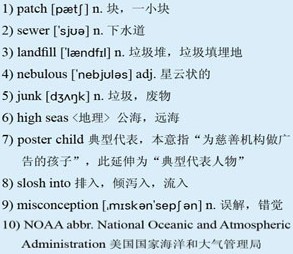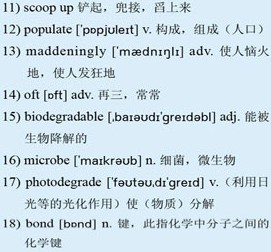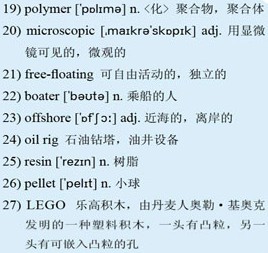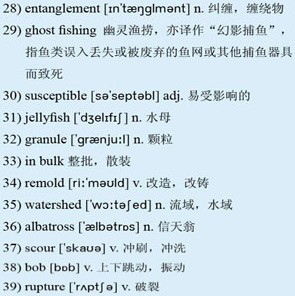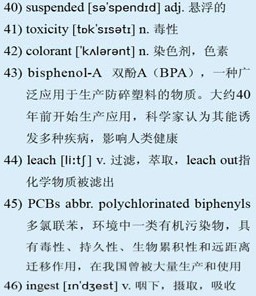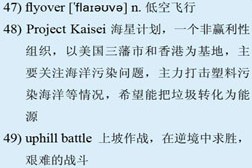文字难度:★★★
Not all garbage ends up at the dump. A river, 2)sewer or beach can't catch everything the rain washes away, either. In fact, Earth's largest 3)landfill isn't on land at all.
并不是所有垃圾最后都归于堆填区。河流、下水道或者沙滩也无法截获所有被雨水冲走的废物。事实上,地球上最大的垃圾堆填区根本就不在陆地上。
The Great Pacific Garbage Patch stretches for hundreds of miles across the North Pacific Ocean, forming a 4)nebulous, floating 5)junk yard on the 6)high seas. It's the 7)poster child for a worldwide problem: plastic that begins in human hands yet ends up in the ocean, often inside animals' stomachs or around their necks. This marine debris has 8)sloshed into the public spotlight recently, thanks to growing media coverage as well as scientists and explorers who are increasingly visiting the North Pacific to see plastic pollution in action.
大太平洋垃圾带漂浮在北太平洋海域上,延绵几百英里,在公海上形成一片星云状的漂浮垃圾场。这正是世界性难题的典型代表:塑料品始于人类之手,然而最后却终于海洋,也常常进到动物的肚子里或是缠绕在其脖子上。最近,这些海洋残滓成功地引起了公众媒体的关注,这要归功于媒体报道的发展,以及那些为了了解塑料污染动态而更频繁地踏足北太平洋的科学家和探险家们。
A Galaxy of Garbage
垃圾银河
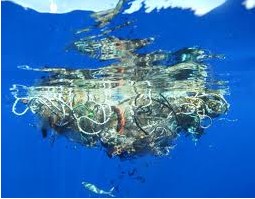 The Great Pacific Garbage Patch has sometimes been described as a “trash island,” but that's a 9)misconception, says Holly Bamford, director of 10)NOAA's Marine Debris Program. If only things were that simple. “We could just go out there and 11)scoop up an island,” Bamford says. “If it was one big mass, it would make our jobs a whole lot easier.”
The Great Pacific Garbage Patch has sometimes been described as a “trash island,” but that's a 9)misconception, says Holly Bamford, director of 10)NOAA's Marine Debris Program. If only things were that simple. “We could just go out there and 11)scoop up an island,” Bamford says. “If it was one big mass, it would make our jobs a whole lot easier.”
大太平洋垃圾带有时会被形容成一座“垃圾岛”,但那其实是一种误解,美国国家海洋和大气管理局“海洋废弃物计划”总监霍莉·班福特如是说。如果事情有这么简单的话,“我们只要去把这个岛铲掉就完事了。”班福特说道,“如果那是一个大整体的话,那我们的工作将会容易很多。”
Instead, it's like a galaxy of garbage, 12)populated by billions of smaller trash islands that may be hidden underwater or spread out over many miles. That can make it 13)maddeningly difficult to study—Bamford says we still don't know how big the garbage patch is, despite the 14)oft-cited claim that it's as big as Texas.
然而,它却像是一条由垃圾组成的银河,由数以亿计的小垃圾岛组成,而且这些岛还可能隐藏在水里或者蔓延很多英里。这足以使得对它的研究困难重重,令人发狂。班福特说,我们仍然不知道这条垃圾带到底有多大,尽管人们常常声称它的面积有(美国)得克萨斯州那么大。
Problems Begin from Plastic
问题始于塑料
While there's still much we don't understand about the garbage patch, we do know that most of it's made of plastic. And that's where the problems begin.
虽然对于这条垃圾带,我们仍有很多不解的地方,但我们明确知道其主要由塑料构成。那也是问题的伊始。
Unlike most other trash, plastic isn't 15)biodegradable—i.e., the 16)microbes that break down other substances don't recognize plastic as food, leaving it to float there forever. Sunlight does eventually “17)photodegrade” the 18)bonds in plastic 19)polymers, reducing it to smaller and smaller pieces, but that just makes matters worse. The plastic still never goes away; it just becomes 20)microscopic and may be eaten by tiny marine organisms, entering the food chain.
与其他大多数垃圾不同,塑料是无法被生物降解的—也就是说,那些能够分解其他物质的微生物不会把塑料当作食物,只会永远任其自流。阳光会最终“光降解”塑料聚合物中的分子链接,将其变成越来越小的片块,但那只会使问题恶化。塑料并没有消失,它只不过变小到要用显微镜才能看到,并且可能被细小的海洋生物吞食,进入到食物链中。
About 80 percent of debris in the Great Pacific Garbage Patch comes from land, much of which is plastic bags, bottles and various other consumer products. 21)Free-floating fishing nets make up another 10 percent of all marine litter. The rest comes largely from recreational 22)boaters, 23)offshore 24)oil rigs and large cargo ships, which drop about 10,000 steel shipping containers into the sea each year, full of things like hockey gloves, computer monitors, 25)resin 26)pellets and 27)LEGOs. But despite such diversity—and plenty of metal, glass and rubber in the garbage patch—the majority of material is still plastic, since most everything else sinks or biodegrades before it gets there.
大太平洋垃圾带80%的废弃物来自陆地,当中大部分是塑料袋、塑料瓶和其他消费品。自由漂浮的渔网占了全部海洋垃圾的10%。剩余的大部分来自休闲娱乐船只、海上石油钻井台和大型货船,这些货船每年都会掉大概一万个钢铁集装箱到海里去,箱里装满诸如曲棍球手套、电脑显示器、树脂颗粒和乐高积木块等物品。在垃圾带里还有大量的金属、玻璃和橡胶,但即便垃圾的种类繁多,其中最大的物质成分仍是塑料,因为其他大部分废弃物在到达这条垃圾带前就已沉入海底或者被生物降解了。
Three Main Problems
三大难题
Marine debris threatens environmental health in several ways. Here are the main ones:
海洋废弃物给环境健康带来多种威胁。以下是一些最主要的问题:
28)Entanglement: The growing number of abandoned plastic fishing nets is one of the greatest dangers from marine debris, Bamford says. The nets entangle seals, sea turtles and other animals in a phenomenon known as “29)ghost fishing,” often drowning them. With more fishermen from developing countries now using plastic for its low cost and high durability, many abandoned nets can continue fishing on their own for months or years.
缠绕物问题:日益增多的废弃塑料渔网是海洋废弃物中最严重的威胁之一,班福特说。这些渔网会缠住海豹、海龟和其他动物,发生“幽灵渔捞”的现象,常常会使这些动物溺毙。如今,因塑料渔网价格低廉且非常耐用,所以发展中国家的渔民使用得越来越多,导致许多渔网在被弃用以后仍继续“捕鱼”数月乃至数年。
Virtually any marine life can be endangered by plastic, but sea turtles seem especially 30)susceptible. In addition to being entangled by fishing nets, they often swallow plastic bags, mistaking them for 31)jellyfish, their main prey.
事实上,任何海洋生物都有可能被塑料危及生命,但海龟似乎尤其容易成为受害者。它们除了会被渔网缠住外,还常常吞下塑料袋,将其误以为是自己的主食—水母。
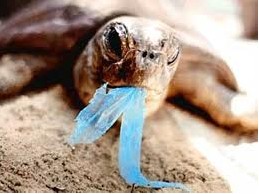 Small surface debris: Plastic resin pellets are another common piece of marine debris; the tiny, industrial-use 32)granules are shipped 33)in bulk around the world, melted down at manufacturing sites and 34)remolded into commercial plastics. Being so small and plentiful, they can easily get lost along the way, washing through the 35)watershed with other plastics and into the sea.
Small surface debris: Plastic resin pellets are another common piece of marine debris; the tiny, industrial-use 32)granules are shipped 33)in bulk around the world, melted down at manufacturing sites and 34)remolded into commercial plastics. Being so small and plentiful, they can easily get lost along the way, washing through the 35)watershed with other plastics and into the sea.
水面小碎片问题:塑料树脂颗粒是另外一种常见的海洋废弃物;这种工业用的细小颗粒被成批地运往世界各地,到了生产点后被加热熔化后再制作成商用塑料品。由于它们体积非常细小,数量众多,所以很容易在运输途中流失,夹杂在水域里的其他塑料中,一起被冲入大海。
36)Albatross parents leave their chicks on land in Pacific islands to go 37)scour the ocean surface for food, namely protein-rich fish eggs. These are small dots 38)bobbing just below the surface, and look unfortunately similar to resin pellets. Well-meaning albatrosses scoop up these pellets—along with other floating trash such as cigarette lighters—and return to feed the indigestible plastic to their chicks, which eventually die of starvation or 39)ruptured organs.
信天翁喜欢将它们的雏鸟留在太平洋的海岛上,然后低飞于海洋表面上寻找食物,也就是那些富含蛋白质的鱼卵。这些小鱼卵一般会贴着水面上下浮动,很不幸地和那些树脂颗粒看上去极其相似。善良的信天翁们衔起这些颗粒—同时还带上其他漂浮垃圾(如打火机)—然后回巢把这些无法消化的塑料喂给雏鸟,结果使它们死于饥饿或器官破裂。
Photodegradation: As sunlight breaks down floating debris, the surface water thickens with 40)suspended plastic bits. This is bad for a couple of reasons. First, Bamford says, is plastic's “inherent 41)toxicity”: It often contains 42)colorants and chemicals like 43)bisphenol-A, which studies have linked to various environmental and health problems, and these toxins may 44)leach out into the seawater. Plastic has also been shown to absorb pre-existing organic pollutants like 45)PCBs from the surrounding seawater, which can enter the food chain—along with BPA and other inherent toxins—if the plastic bits are accidentally 46)ingested by marine life.
光降解问题:阳光降解了漂浮废弃物,悬浮的塑料微粒使水面变得粘稠。这将带来几个方面的危害。班福特说,首先,塑料具有“先天毒性”:它通常含有色素和一种叫做双酚A的物质,这种物质被证实与多种环境和健康问题有关,而且这些毒素可能会渗入到海水中。塑料还被证实会从周围的海水中吸收先已存在的有机污染物,如多氯联苯,如果这些塑料微粒被海洋生物意外摄食的话,那些污染物、加上双酚A和塑料固有的其他毒素都会进入到食物链中。
Things that We Can Do
我们能做的事
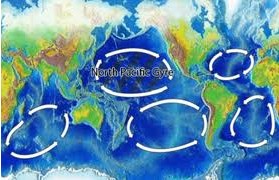 The discoverer of the Great Pacific Garbage Patch, Capt. Charles Moore, once said a cleanup effort “would bankrupt any country and kill wildlife in the nets as it went.” “He makes a really good point there,” Bamford says. “It's very difficult.” Still, NOAA conducts 47)flyovers to study the garbage patch, and two research teams recently sailed there to collect debris and water samples. Meanwhile, the international 48)Project Kaisei team also recently spent time in the garbage patch, studying its contents in hopes of eventually recycling them or turning them into fuel.
The discoverer of the Great Pacific Garbage Patch, Capt. Charles Moore, once said a cleanup effort “would bankrupt any country and kill wildlife in the nets as it went.” “He makes a really good point there,” Bamford says. “It's very difficult.” Still, NOAA conducts 47)flyovers to study the garbage patch, and two research teams recently sailed there to collect debris and water samples. Meanwhile, the international 48)Project Kaisei team also recently spent time in the garbage patch, studying its contents in hopes of eventually recycling them or turning them into fuel.
大太平洋垃圾带的发现者—查尔斯·摩尔海军上校,曾经说过对这垃圾带进行全面大清扫“将会使任何国家破产,而且清理过程中难免会导致大量野生生物丧命网中。”“他所言极是。”班福特说,“这真的非常困难。”虽然如此,美国国家海洋和大气管理局还是进行了飞行行动以研究这条垃圾带,有两个研究小组最近航行前往收集废弃物和水质样品。与此同时,国际“海星计划”小组最近也开始在这条垃圾带上投入时间,研究其成分以期最终能够将其回收或转化成燃料。
Ultimately, more plastic recycling and wider use of biodegradable materials is the best hope for controlling these garbage patches, Bamford says, but that's an 49)uphill battle.
最终来讲,更多地回收塑料和更广泛地使用可生物降解的材料才是控制这些垃圾带的最佳可行方法,班福特说道,但那会是一场艰苦的战斗。
“We need to turn off the taps at the source. We need to educate people on the proper disposal of things that do not break up, like plastics,” she says. “Opportunities for recycling have to increase, but, you know, some people buy three bottles of water a day. As a society, we have to get better at reusing what we buy.”
“我们需要截断问题的来源。我们需要教育人们如何正确弃置那些不可降解的物品,比如塑料制品。”她说,“(我们)必须增加回收利用的机会,但是,你知道的,有些人一天就要买三瓶水。作为社会的一份子,我们必须更好地再利用我们所购买的东西。”
